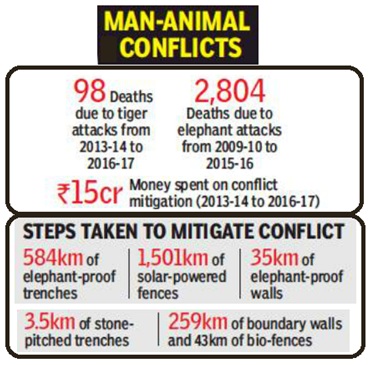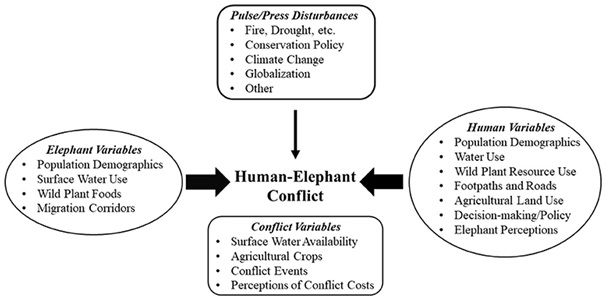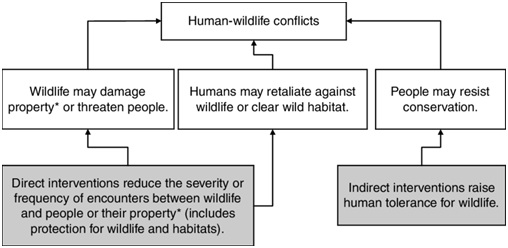In news
- Telangana State government recently constituted a 10-member committee to suggest measures to mitigate man-animal conflict and recommend steps for avoiding the recurrence of human deaths due to tiger attacks.
- Project RE-HAB (Reducing Elephant-Human Attacks using Bees) was launched in Karnataka which entails installing bee boxes along the periphery of the forest (Nagarahole National Park and Tiger Reserve) and the villages to mitigate human-elephant conflict.
- Out of the nearly 225 living species of non-human primates, monkeys, along with Greylangurs and bonnet macaques, have adapted to urban habitats over the years.
Introduction:
- According to IUCN 2020, it refers to the interaction between wild animals and humans which results in a negative impact on people, animals, resources, and habitats.
- It is defined by the World Wide Fund for Nature (WWF) as "any interaction between humans and wildlife that results in negative impacts of human social, economic or cultural life, on the conservation of wildlife populations, or the environment.
- It occurs when growing human populations overlap with established wildlife territory which creates competition for space and resources.
- Conflicts between man and animal have occurred since the dawn of humanity. However, it has come to light more frequently in recent times.
- It is a serious global threat to sustainable development, food security, and conservation in urban and rural landscapes alike.
- In general, the consequences include the destruction of crops, reduced farm productivity, competition for grazing lands and water, livestock predation, injury and death to farmers, damage to infrastructure, and increased risk of disease transmission among wildlife and livestock.
|
Examples of Man-animal conflict:
- Predation on livestock or domestic animals by wild animals
- Damage to crops and fences
- Wildlife strewing about residential garbage
- Vehicle/wildlife collisions
- Aircraft/bird collisions
- Damage caused by squirrels or bats to fruit and fruit trees
- Birds nesting in undesirable residential locations
|

Causes of Man-animal conflict:
- Expansion of human settlements into forests - these are inclusive of expansion of cities, industrial areas, railway/road infrastructure, tourism, etc.
- Transport infrastructure - The expansion of road and rail networks through forest ranges has resulted in animals getting killed or injured in accidents on roads or railway tracks.
- Urbanization - In the 21st century, rapid urbanization and industrialization have led to the diversion of forest land to non-forest purposes, as a result, the wildlife habitat is shrinking.
- Grazing - Allowing livestock to graze in forest areas has enhanced the chances of interaction between domesticated animals and wild animals.
- Land use transformation - These include changes from protected forest patches to agricultural and horticultural lands and monoculture plantations which are further destroying the habitats of wildlife and bringing wild animals into contact with humans.
- Unsound forest management techniques - Unscientific practices of forest management in the country have failed to reverse the anthropogenic damage caused to the forests which decrease the habitat availability for wild animals and force them out of the forest areas.
- Invasives - Infestation of wildlife habitat by invasive exotic weeds leads to decreased availability of edible grasses for wild herbivores which enhances chances of conflict between man and animals.
- Reduction in Prey population - Decreased prey base, caused by poaching of herbivores, has resulted in carnivores moving out of the forests in search of prey and indulging in cattle lifting. E.g. Deer population is decreasing.
- Lack of food availability in the vicinity - Animal fails to find food in their surroundings and therefore, venture into human habitations and agricultural fields. E.g.- Elephants venturing into agricultural lands. The elephants need to travel at least 10-20 km a day. If a herd is restricted to an area of about 100 sq km, they are bound to move out in search of food and water. Elephants are used to traveling long distances, most of which fall outside the protected areas,
- Water pollution - Poisoning of water bodies by runoffs has made the wild animals look for clean potable water in the human habitations.
- Population explosion - The increasing population has also led to many human settlements coming up near the fringes and peripheries of protected areas and encroachment in the forest lands by local people for cultivation and collection of food and fodder etc. These have led to increasing pressure on limited natural resources in the forests, and a rise in man-animal conflict.
- Habitat degradation - E.g. Tiger requires 60 to 100 square km of space but Maharashtra’sBor Tiger reserve is just 138 square km in the area which forces tiger out of the reserve to search for food.
- Failed protected areas - The condition of the existing protected areas is not very good, either. Wildlife experts claim that territorial animals do not have enough space within reserves and their prey do not have enough fodder to thrive on. This is forcing the wild animals to move out and venture close to human habitation in search of food.

Man-animal Conflicts in Marine Ecosystems:
- Human-wildlife conflict is not limited to terrestrial ecosystems but is prevalent in the world’s oceans as well.
- As with terrestrial conflict, human-wildlife conflict in aquatic environments is incredibly diverse and extends across the globe.
- In Hawaii, for example, an increase in monk seals around the islands has created a conflict between locals who believe that seals “belong” and those who do not.
- Marine predators such as killer whales and fur seals compete with fisheries for food and resources, while others like great white sharks have a history of injuring humans.
- While many of the causes of man-animal conflict are the same between terrestrial and marine ecosystems, ocean environments are less studied.
Hidden Dimensions of Man-animal Conflict:
- Human-wildlife conflict also has a range of 'hidden' dimensions that are not typically considered when the focus is on visible consequences.
- These can include health impacts, opportunity costs, and transaction costs.
- Case studies include work on elephants in northeast India, where human-elephant interactions are correlated with the increased imbibing of alcohol by crop guardians with resultant enhanced mortality in interactions, and issues related to gender in northern India.
- Besides, research has shown that the fear caused by the presence of predators can aggravate human-wildlife conflict more than the actual damage produced by encounters.

Repercussions of Man-animal conflict:
- Injury and loss of life of humans and wildlife
- Crop damage
- Livestock depredation
- Predation of managed wildlife stock
- Damage to human property
- Destruction of habitat
- Collapse of wildlife populations
- Reduction of geographic range

Preventive measures and Mitigation Strategies:
- Improvement of habitat-
- In-situ and ex-situ habitat conservation measures will help in securing animals their survival.
- Re-location -
- Re-locating animal habitats away from residential and commercial centers will serve to minimize animal-man conflict for illegal and self-interested motives
- Translocation of problematic animals -
- Relocating the "problem" animals from a site of conflict to a new place is a mitigation technique used in the past.
- However, recent research has shown that this approach could have detrimental impacts on species and is largely ineffective.
- It could decrease survival rates and lead to extreme dispersal movements for a species, and often "problem" animals could resume conflict behavior in their new location.
- Erection of fences or other barriers-
- The construction of boundary walls and solar fences around the sensitive areas to prevent wild animal attacks.
- Building barriers around cattle
- Creating distinct wildlife corridors
- Erecting beehive fences around farms to deter elephants
- These have all demonstrated the ability to be successful and cost-effective strategies for mitigating man-animal conflict.
- Spatial analyses and mapping conflict hotspots -
- Mapping interactions and creating spatial models have been successful in mitigating human-carnivore conflict and human-elephant conflict, among others.
- In Kenya, for example, using grid-based geographical information systems in collaboration with simple statistical analyses allowed conservationists to establish an effective predictor for human-elephant conflict.
- Surveillance-
- Increased vigilance and protection of identified locations using hi-tech surveillance tools like sensors can help in tracking the movement of animals and warn the local population.
- Effective land-use planning -
- Altering land-use practices can help mitigate conflict between humans and crop-raiding animals.
- For example in Mozambique, communities started to grow more chili pepper plants after making the discovery that elephants dislike and avoid plants containing capsaicin.
- This creative and effective method discourages elephants from trampling community farmers' fields as well as protects the species.
- Predator-deterring guard dogs -
- The use of guard dogs to protect livestock from depredation has been effective in mitigating human-carnivore conflict around the globe.
- A recent review found that 4% of study cases researching human-carnivore conflict used livestock-guarding dogs as a management technique, with animal losses on average 60 times lower than the normal.
- Managing garbage to prevent the attraction of carnivores -
- Poor disposal of garbage such as hotel waste is rapidly emerging as an important aspect that heightens human-carnivore conflicts in countries such as India.
- Urgent research to increase knowledge of the impact of easily available garbage is needed, and improving the management of garbage in areas where carnivores reside is essential.
- Improving community education and perception of animals-
- Various cultures have myriad views and values associated with the natural world, and how wildlife is perceived could play a role in exacerbating or alleviating man-animal conflict.
- In one Masaai community where young men once obtained the status by killing lions, conservationists worked with community leaders to shift perceptions and allow those young men to achieve the same social status by protecting lions instead.
- Awareness Programmes-
- To create awareness among people and sensitize them about the Do’s and Don’ts in the forest areas to minimize the conflicts between man and animal.
- Training programs-
- Training to the police offices and local people should be provided for this purpose forest department should frame guidelines.
- Technical and financial support-
- For the development of necessary infrastructure and support facilities for immobilization of problematic animals through tranquilization, their translocation.
- Compensation-
- In some cases, governmental systems have been established to offer monetary compensation for losses sustained due to man-animal conflict.
- These systems hope to deter the need for retaliatory killings of animals and to financially incentivize the co-existence of humans and wildlife.
- Compensation strategies have been employed in India, Italy, and South Africa, to name a few.
- The success of compensation in managing human-wildlife conflict has varied greatly due to under-compensation, a lack of local participation, or a failure by the government to provide timely payments.
- Crop insurance should be provided in the event of destruction by wild animals.
- Utilizing add-on coverage under the Pradhan Mantri Fasal Bima Yojna for crop compensation against crop damage due to man-animal conflict.
- Part of CSR -
- Safeguarding Tiger corridors, building eco-bridges, and such conservation measures can be part of corporate social responsibility.
- Part of India’s Conservation Culture -
- People have accepted the coexistence of humans & animals and incorporated it into our culture. All our deities have animals associated with them; it shows the inclusion of these animals in our mind space.
- The Velip community in Goa worship the tigers and this practice is done even today.
- Animals are viewed also as a renewable resource. Unlike activities such as mining, tigers are a renewable resource. They are always going to be there, and so will the rivers and the forests, giving the local people income and development — as long as there are tigers.

Best Practices and Recent Advances in Mitigation Strategies:
- Managing Human-Elephant conflict
- Tamil Nadu - Elephant proof trenches
- Karnataka - Hanging Fences, rubble walls
- West Bengal- Chilly smoke
- Assam- Sound of bees
- Use of technology - Individual identification, monitoring of elephants in south Bengal, and sending SMS alerts to warn of elephant presence.
- Eco-bridges
- It includes canopy bridges (usually for monkeys, squirrels, and other arboreal species); concrete underpasses or overpass tunnels or viaducts (usually for larger animals); and amphibian tunnels or culverts. Usually, these bridges are overlaid with planting from the area to give it a contiguous look with the landscape.
- Ramnagar Forest Division in Nainital district, Uttarakhand, recently built its first eco-bridge for reptiles and smaller mammals.
- Firefly bird diverter
- The Ministry of Environment Forest and Climate Change (MoEFCC) along with the Wildlife Conservation Society (WCS) India has come up with a unique initiative a “firefly bird diverter” for overhead power lines in areas where Great Indian Bustard (GIB) populations are found in the wild.
- Firefly bird diverters are flaps installed on power lines. They work as reflectors for bird species like the GIB. Birds can spot them from a distance of about 50 meters and change their path of flight to avoid collision with power lines.
- Project REHAB
- A pilot project RE-HAB (Reducing Elephant-Human Attacks using Bees) was launched in Karnataka which entails installing bee boxes along the periphery of Nagarahole National Park and Tiger Reserve and the villages to mitigate human-elephant conflict.
- It is an initiative of the Khadi and Village Industries Commission (KVIC) and is a sub-mission of KVIC’s National Honey Mission.
- It is intended to create “bee fences” to thwart elephant attacks in human habitations using honeybees. It will also increase honey production and farmers’ income.
Way forward:
- Landscape based approach and habitat revamping -
- In Sundarbans, the tiger population increased from 87 to 96 due to habitat protection and landscape-based approach.
- Co-existence -
- g. On the Samruddhi e-expressway (Mumbai to Nagpur), which is rich in flora and fauna, various underpasses and overpasses were built.
- Corridors and bridges must be promoted.
- Role of state government -
- g. Central government was planning a railway line from Akola to Khandwa which passes through the core of the Melghat tiger reserve.
- Therefore, the state government asked for alternatives to the route.
- Gadgil committee
- It has been said that Western Ghats are ecologically sensitive zone (ESZ).
- Therefore, no mining and industrial activity should take place, and if already present, it must be stopped.
- But states are opposing this recommendation, which reveals the intention of the politicians.
Conclusion:
- The solutions are simple: Inclusive development with a long-term vision that cares for the environment.
- Eco-centric tourism must be promoted so that the unique habitats of animals do not get disturbed or polluted.
- Maintaining and managing the national parks and wildlife sanctuaries in a proper manner to minimize man-animal conflicts.
- Poaching of wild animals should be stopped so, that the number of wild animals can stabilize at its carrying capacity allowing it to reach equilibrium in the ecosystem. Thus, equilibrium in the numbers of prey and predators in the forest ecosystem would be maintained.
- We need to involve local communities who could be the custodians of the wild animals. Correspondingly, the decrease in the conflicts could provide these communities much-needed time, space, and resources for development in such remote areas.
- Environmental justice could be achieved only if we drift away from principles like sustainable development and polluter pays principles, as these principles are based on a strong bias towards the interests of human beings rather than environmental concerns. When choosing between development and the environment, the tilt should always be towards saving the environment.




